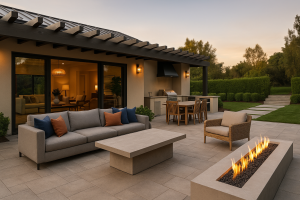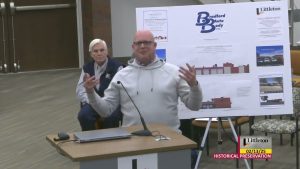Many homeowners who are looking to update their kitchen or bathroom cabinets often wonder: is cabinet resurfacing the same thing as cabinet refacing? While the two terms may sound similar, there are distinct differences between the two methods. In this section, we will explore the question of whether cabinet resurfacing and cabinet refacing are the same thing, and examine the key differences between the two methods.
By the end of this section, readers will have a clearer understanding of the nuances of cabinet resurfacing and cabinet refacing and be better equipped to make an informed decision about which method is best suited for their needs.
What is Cabinet Resurfacing?
Cabinet resurfacing involves applying a thin layer of new material, such as laminate or veneer, over the existing cabinet boxes. The process also includes replacing the cabinet doors, drawer fronts, and hardware to give your cabinets a fresh new look.
One of the main benefits of cabinet resurfacing is that it can be completed quickly and at a fraction of the cost of purchasing new cabinets. It is also a great option for homeowners who want to update their cabinets without undergoing a full renovation.
The process of cabinet resurfacing begins by cleaning and sanding the existing cabinet boxes, then applying the new material. This material can come in a wide range of colors and finishes, allowing you to choose the perfect style to match your existing decor. Once the new material is applied, the cabinet doors and drawer fronts are replaced and new hardware is installed.
Cabinet resurfacing is a smart choice for homeowners who want to transform the look of their kitchen or bathroom without breaking the bank. With this cost-effective and efficient method, you can enjoy a brand new look for your cabinets in no time.
What is Cabinet Refacing?
Cabinet refacing is a process that involves removing the existing cabinet doors, drawer fronts, and hardware, and replacing them with new ones. The cabinet boxes are then covered with a veneer or laminate that matches the new doors and drawers, resulting in a completely new look for the cabinets.
The process of cabinet refacing typically takes a few days to complete, and involves minimal disruption to your daily routine. In fact, you can still use your kitchen or bathroom during the refacing process, making it an ideal choice for homeowners who want to update their cabinets without having to undergo a full renovation.
One of the key benefits of cabinet refacing is that it is often less expensive than a full cabinet replacement. Additionally, there are numerous design options to choose from, including different types of wood, finishes, and hardware, ensuring that you can find the perfect style to match your home’s décor.
| Pros | Cons |
|---|---|
| Cabinet refacing is cost-effective compared to a full replacement | Refacing may not be possible if the cabinets are structurally unsound or have water damage |
| Minimal disruption to daily routine during the refacing process | May not be as durable as new cabinets, although the lifespan can be extended with proper care |
| Wide range of design options to choose from | May not be suitable if you want to change the layout or configuration of your cabinets |
The Key Differences Between Cabinet Resurfacing and Cabinet Refacing
While cabinet resurfacing and cabinet refacing may sound similar, they are two distinct methods of updating kitchen or bathroom cabinets. Here are the key differences between the two:
| Cabinet Resurfacing | Cabinet Refacing |
|---|---|
| Uses a thin veneer or laminate to cover existing cabinet surfaces | Replaces cabinet doors and drawer fronts, while veneering the cabinet faces |
| Doesn’t require the removal of existing cabinet doors or drawers | Requires the removal and replacement of cabinet doors and drawer fronts |
| Can be completed in as little as a day or two | May take several days to a week to complete |
| Can be a more budget-friendly option | May be more expensive due to the cost of new cabinet doors and drawer fronts |
Ultimately, the decision between cabinet resurfacing and cabinet refacing will depend on individual preferences, time, and budget constraints. It is important to understand the differences between the two methods to make an informed decision.
Factors to Consider when Choosing between Cabinet Refacing and Cabinet Resurfacing
When it comes to updating your kitchen or bathroom cabinets, choosing between cabinet refacing and cabinet resurfacing can be a tough decision. Both methods have their benefits and drawbacks, and homeowners should take several factors into consideration before making a final decision.
Budget
One of the most significant factors to consider is budget. Cabinet refacing can be more expensive than cabinet resurfacing, mainly if you’re updating a larger kitchen. However, it’s essential to take the long-term perspective into account. While cabinet resurfacing can be cheaper upfront, it may not last as long as cabinet refacing, which could lead to higher costs in the long run.
Time Constraints
Another critical factor is time. Cabinet refacing typically takes longer than cabinet resurfacing, which can disrupt your daily routine more significantly. If you need your kitchen back in working condition quickly, cabinet resurfacing may be a better option for you.
Desired Outcome
Ultimately, the right method for you depends on what you want to achieve. Cabinet refacing offers more design options, allowing for a more customized look. Cabinet resurfacing, on the other hand, provides a quick and straightforward way to give your cabinets a fresh look.
Considering these factors and your unique circumstances can help you make an informed decision about whether cabinet refacing or cabinet resurfacing is the right choice for your home.
The Cost of Cabinet Refacing vs Cabinet Resurfacing
Cabinet refacing and resurfacing can provide homeowners with a cost-effective alternative to replacing their kitchen or bathroom cabinets. However, each method comes with its own set of expenses. Here, we’ll take a closer look at the typical costs associated with cabinet refacing and cabinet resurfacing.
| Expense | Cabinet Refacing | Cabinet Resurfacing |
|---|---|---|
| Materials | $100-$300 per linear foot | $1,000-$3,000 for an average kitchen |
| Labor | $1,000-$2,500 for an average kitchen | $500-$1,500 for an average kitchen |
| Other Costs (e.g., removal and disposal of old cabinets, hardware, etc.) | $500-$1,000 for an average kitchen | $0-$500 for an average kitchen |
As the table above illustrates, cabinet resurfacing is generally less expensive than cabinet refacing due to the lower costs of materials and labor. However, it’s worth noting that prices can vary depending on the size of your kitchen or bathroom, the materials used, and the complexity of the job.
Overall, cabinet refacing tends to be a more costly option than cabinet resurfacing. Nevertheless, the investment may be worthwhile if you’re seeking a broader range of design options or want to completely change the appearance of your cabinets.
Earth Saving Solutions: Environmentally Friendly Cabinet Updates
At Earth Saving Solutions, we believe in creating sustainable and eco-friendly cabinet updates. We specialize in cabinet refacing and resurfacing using only environmentally conscious products and techniques. We understand the importance of preserving our planet and reducing waste, which is why we are committed to offering green alternatives to traditional cabinet updates.
| Our Commitment to the Environment |
|---|
| We use low VOC (volatile organic compounds) products that emit fewer harmful toxins into the air. |
| We offer a variety of sustainable materials, such as reclaimed wood and bamboo, for cabinet updates. |
| We recycle and repurpose old materials to reduce waste and promote a circular economy. |
By choosing Earth Saving Solutions, you can update your cabinets while also doing your part to protect the environment. Our team of experts will guide you through the process and help you choose the best eco-friendly options for your needs. Contact us today to learn more about our services.
Meet Chris Hock: Licensed Colorado General Contractor
If you are considering cabinet refacing or resurfacing in Colorado, you may want to touch base with Chris Hock, a licensed general contractor with years of experience in the industry. Chris has built a solid reputation for delivering outstanding cabinet updates that meet the unique needs and preferences of his clients.
With a strong background in construction and remodeling, Chris is equipped with the skills and expertise needed to handle various cabinet refacing and resurfacing projects. He is committed to providing high-quality service, exceptional craftsmanship, and attentive customer support to ensure that every project is a success.
Beyond his technical knowledge and experience, what sets Chris apart is his passion for his work. He takes great pride in transforming outdated cabinets into beautiful, functional, and inviting features that enhance the overall look and feel of a space.
Advantages of Cabinet Refacing
Cabinet refacing is a popular option for homeowners who want to update the look of their cabinets without the cost and hassle of a complete replacement. Here are some of the key advantages of choosing cabinet refacing:
- Cost savings: Refacing cabinets is typically less expensive than replacing them entirely. This is because you’re keeping the existing cabinet boxes and simply replacing the doors and hardware.
- Less disruption: Refacing cabinets is a less invasive process than replacing them, meaning there is less mess and disruption to your kitchen or bathroom during the project.
- Design options: With cabinet refacing, you have a wide range of design options to choose from. You can select new cabinet doors in a variety of styles and finishes, and even add features like glass inserts or new hardware.
Overall, cabinet refacing can be a great option for homeowners looking to update their cabinets while keeping costs and disruption to a minimum.
Advantages of Cabinet Resurfacing
Cabinet resurfacing offers several benefits that make it an attractive option for homeowners looking to update their kitchen or bathroom cabinets. Some key advantages are:
- Cost-effectiveness: Cabinet resurfacing is generally less expensive than cabinet refacing or replacement, making it a budget-friendly option for those who want to give their cabinets a facelift without breaking the bank.
- Durability: Resurfaced cabinets are typically coated with a durable finish that can withstand daily wear and tear, making them a long-lasting choice for your home.
- Customization: With cabinet resurfacing, you have a wide range of finishes to choose from, including wood grains, solid colors, and other textures, allowing you to customize your cabinets to your specific taste.
Additionally, cabinet resurfacing is a relatively quick and non-invasive process. Unlike cabinet replacement, which can take weeks and require a complete overhaul of your kitchen, cabinet resurfacing can often be completed in just a few days, with minimal disruption to your daily routine.
Overall, cabinet resurfacing can be an excellent option for homeowners who want to refresh their cabinets without breaking the bank or undergoing a lengthy renovation. The many benefits of this method make it a popular choice for those who want a cost-effective, durable, and customized solution for their home.
FAQ: Is Cabinet Resurfacing the Same Thing as Cabinet Refacing?
Many people use the terms cabinet resurfacing and cabinet refacing interchangeably, but they are not exactly the same thing.
What is the difference between cabinet resurfacing and cabinet refacing?
Cabinet resurfacing involves applying a new surface material, such as veneer or laminate, over the existing cabinet boxes while leaving the original structure intact. Cabinet refacing, on the other hand, involves replacing the doors, drawer fronts, and hardware while also applying new veneers to the cabinet boxes to match the new doors. Essentially, cabinet resurfacing is a less invasive and more cost-effective method than cabinet refacing.
Can I do cabinet resurfacing or cabinet refacing myself?
Both cabinet resurfacing and cabinet refacing require a certain level of skill and experience, so it’s recommended to hire a professional if you’re not familiar with the process. Trying to do it yourself may result in mistakes that could damage your cabinets.
What are the benefits of cabinet resurfacing?
Cabinet resurfacing can be a great option if you want to update the look of your cabinets without breaking the bank. It is also an eco-friendly option that reduces waste by using the existing cabinet boxes. Additionally, cabinet resurfacing can be completed in a relatively short amount of time compared to other kitchen or bathroom remodeling projects.
What are the benefits of cabinet refacing?
Cabinet refacing provides more design options than cabinet resurfacing, as you can choose entirely new door styles and hardware. It also adds more value to your house as it can significantly improve the appearance of your kitchen or bathroom. Cabinet refacing can be a good choice if you have a larger budget or if your cabinets have significant damage that requires replacement.
Which is more expensive, cabinet resurfacing or cabinet refacing?
Cabinet refacing is generally more expensive than cabinet resurfacing because it involves replacing more components, such as the doors and hardware. The cost of both methods will depend on factors such as the size of your cabinets and the materials used for the resurfacing or refacing.
By understanding the differences between cabinet resurfacing and cabinet refacing, you can make an informed decision about which option is best for your budget, timeline, and desired outcome.









